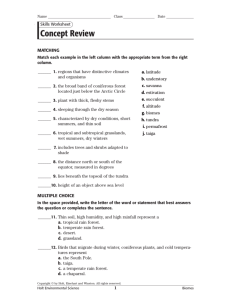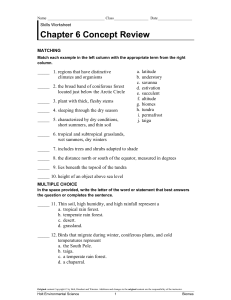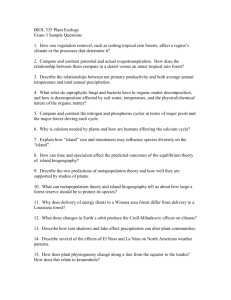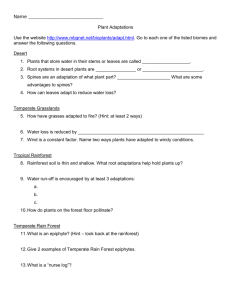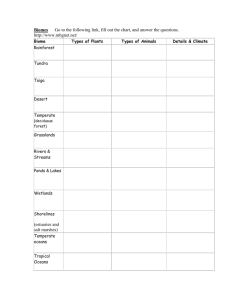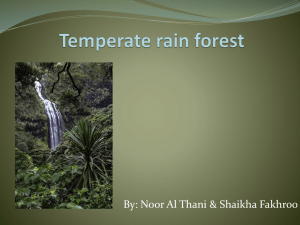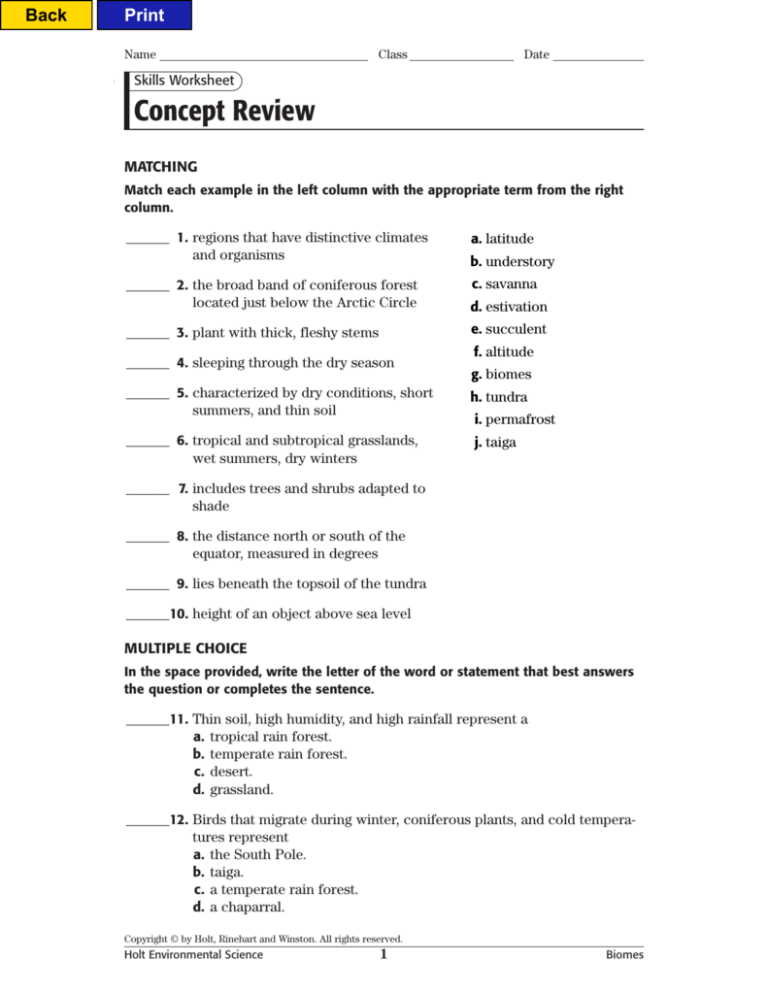
Back
Print
Name
Class
Date
Skills Worksheet
Concept Review
MATCHING
Match each example in the left column with the appropriate term from the right
column.
______ 1. regions that have distinctive climates
and organisms
a. latitude
b. understory
c. savanna
______ 2. the broad band of coniferous forest
located just below the Arctic Circle
d. estivation
______ 3. plant with thick, fleshy stems
e. succulent
______ 4. sleeping through the dry season
______ 5. characterized by dry conditions, short
summers, and thin soil
______ 6. tropical and subtropical grasslands,
wet summers, dry winters
f. altitude
g. biomes
h. tundra
i. permafrost
j. taiga
______ 7. includes trees and shrubs adapted to
shade
______ 8. the distance north or south of the
equator, measured in degrees
______ 9. lies beneath the topsoil of the tundra
______10. height of an object above sea level
MULTIPLE CHOICE
In the space provided, write the letter of the word or statement that best answers
the question or completes the sentence.
______11. Thin soil, high humidity, and high rainfall represent a
a. tropical rain forest.
b. temperate rain forest.
c. desert.
d. grassland.
______12. Birds that migrate during winter, coniferous plants, and cold temperatures represent
a. the South Pole.
b. taiga.
c. a temperate rain forest.
d. a chaparral.
Copyright © by Holt, Rinehart and Winston. All rights reserved.
Holt Environmental Science
1
Biomes
Back
Print
Name
Class
Date
Concept Review continued
______13. The top layer in a tropical rain forest is the
a. canopy.
b. understory.
c. emergent layer.
d. tree line.
______14. Extreme temperatures, abundant precipitation, rich, deep soils, and a
growing season of four to six months represent a
a. tropical rain forest.
b. taiga.
c. temperate deciduous forest.
d. savanna.
______15. The biome with the highest species diversity is the
a. taiga.
b. tundra.
c. tropical rain forest.
d. savanna.
______16. Hot summers and cold winters, low to moderate rainfall, few trees,
and rich, fertile soil represent a
a. tundra.
b. temperate grassland.
c. temperate deciduous forest.
d. desert.
______ 17. As you move from the equator toward the North Pole, you would be
likely to see
a. rain forests, then deserts, then taiga.
b. tundra, then deserts, then grasslands.
c. grasslands, then tundra, then rain forests.
d. temperate deciduous forests, then taiga, then rain forests.
______18. Factors that influence where plants grow include
a. longitude.
b. climate.
c. biome maps.
d. Both (a) and (b)
Copyright © by Holt, Rinehart and Winston. All rights reserved.
Holt Environmental Science
2
Biomes
Back
Print
TEACHER RESOURCE PAGE
Answer Key
Concept Review
MATCHING
1.
2.
3.
4.
5.
6.
7.
8.
9.
10.
conifer’s ability to affect the soil
through its needles. When its needles
drop, they acidify the soil surrounding the tree, making the soil inhospitable for plants that might
otherwise grow near the conifer and
compete with it for water, nutrients,
and sunlight.
MULTIPLE CHOICE
11.
12.
13.
14.
15.
16.
17.
18.
g
j
e
d
h
c
b
a
i
f
a
b
c
c
c
b
a
b
AGREE OR DISAGREE
14. Answers may vary. Sample answer:
Agree; biome describes the general
plant and animal community that
dominates a given region. Example:
different types of deciduous forest
are all considered temperate deciduous forest. Also, biomes contain
ecosystems that are not included in
the overall biome profile. For example, temperate forests and taiga contain fields (grasslands).
15. Answers may vary. Sample answer:
Agree; while many of the native grasslands of our planet have been
destroyed with the introduction of
farmland, this change was crucial to
the success of humans as a species. To
support the agriculture of our growing
populations, we needed to use the
most fertile land. The United States
has been particularly successful at
grassland agriculture.
16. Answers may vary. Sample answer:
Agree; many medicines come from
plants that grow only in the tropical
rain forests, which are being cleared
rapidly for activities such as logging
and agriculture. Tropical rain forests
once covered about 20 percent of
Earth’s surface but now cover only
about 7 percent. If the clearing of rain
forests continues at its present rate,
many rain forest species are likely to
become extinct. Many of these species
are plants that could be useful for
fighting diseases.
Critical Thinking
ANALOGIES
1.
2.
3.
4.
5.
b
b
d
c
c
6.
7.
8.
9.
10.
d
d
b
a
a
INTERPRETING OBSERVATIONS
11. Answers may vary. Sample answer:
Plant 1 is a deciduous tree found in a
temperate forest. Its broad leaves help
it absorb energy in the summer while
its height shades out competition. The
leaves drop in autumn so that the tree
can better survive long winters when
water is scarce or frozen.
12. Answers may vary. Sample answer:
Plant 2 is a cactus. Its succulent flesh
stores water, allowing it to weather
the hot, dry desert climate. Its stems
have a waxy coating to preserve water
and spines to protect it from predators. The cactus’s long, shallow root
system helps it collect as much water
as possible during the desert’s infrequent rains.
13. Answers may vary. Sample answer:
Plant 3 is a coniferous tree found in
the taiga. Its needle-like leaves help it
to preserve water which is scarce or
frozen during the winter, and its
pyramidal shape helps it shed heavy
snow. Another adaptation is the
REFINING CONCEPTS
17. Accept any reasonable answer. Sample
answer: An example of a sustainable
Copyright © by Holt, Rinehart and Winston. All rights reserved.
Holt Environmental Science
98
Biomes

